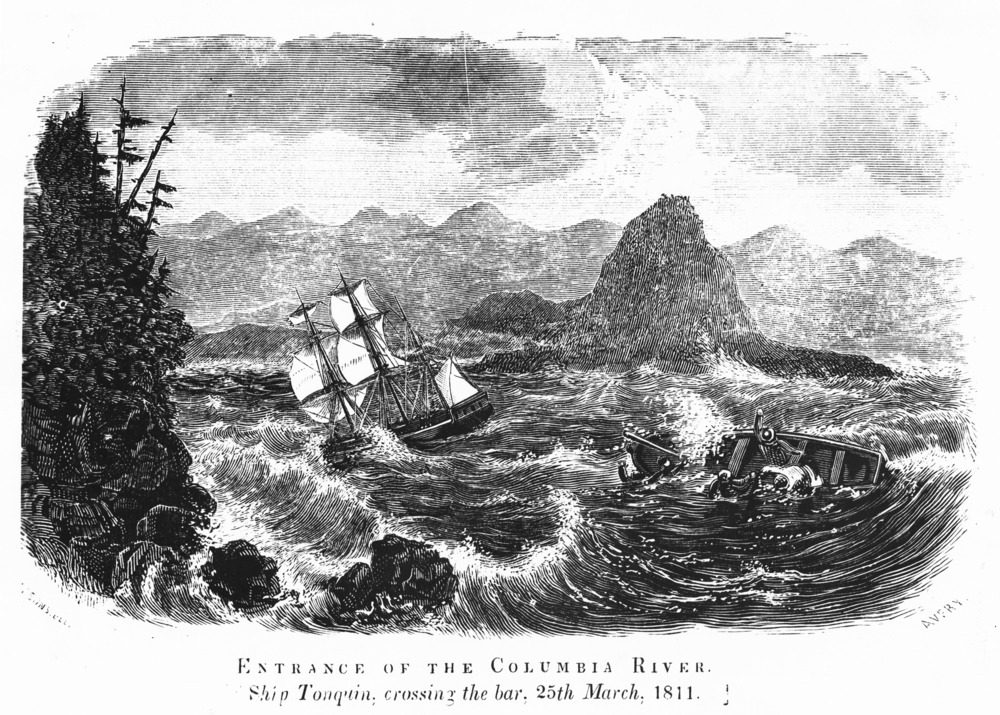The Tonquin, built in 1807, was described by Edmund Fanning, its builder, as “a first-rate ship and fast sailing vessel.” The ninety-four-foot, three-masted ship was copper bottomed and carried ten small cannon, mounted. On a day of strong wind in late March 1811, the crew of the Tonquin, out of New York, sailed the ship across the rough bar into the Columbia River.
The Tonquin’s owner, John Jacob Astor of New York, established a fur-trading post at the mouth of the Columbia in the spring of 1811. Called Astoria, the post became the earliest EuroAmerican settlement on the Pacific Coast between Spain’s San Francisco mission and Russia’s New Arkhangel (Sitka). Astor’s selection as the ship’s commander was U.S. Navy Lieutenant Jonathan Thorn, who was on leave from the military and had no experience in the Pacific or in the fur trade. His passengers described him as irascible and insensitive to their welfare and to the well-being of the crew. A few of the ship’s thirty-three passengers who debarked on the south side of the Columbia River were partners in Astor’s new Pacific Fur Company, including Astoria co-founder Alexander McKay. The others were clerks (traders), voyageurs, and tradesmen; twelve were Hawaiians.
With the new post partly built, Thorn sailed from the Columbia on June 5, 1811. The plan was to find and meet with Aleksandr Baranov at New Arkhangel, to trade supplies and barrels of gunpowder for fur skins, and to return to Astoria. The summer went by, but the Tonquin did not return. Rumors from Indians that the crew had been attacked alarmed the settlement. The first report that the ship was lost was recorded at Astoria by Duncan McDougall on August 11. One of the Chinooks with contacts at the post had met a party of natives from the north who had passed on the news.
Reportedly, fifty to sixty canoes of the Neweetees (Nahwitti) had followed the Tonquin along Vancouver Island, and some of the Nuu-chah-nulth tribe had joined in near Nootka Sound. As described later in memoirs by some of the passengers left behind at the new settlement—Robert Stuart, Gabriel Franchère, and Alexander Ross—the Nahwitti men had followed the ship, boarded it from their large dugouts, and attacked the crew. An armed struggle took place on board and, at its climax, the ship was blown up with the gunpowder it carried. None of the crew survived and approximately a hundred Nahwitti and Nootkans were killed. The interpreter with the Tonquin, George Ramsay, who may have been a Chinook, later returned to the Columbia. Researchers now believe the fight over the ship took place on the coastline a few miles south of Nootka Sound.
-
![Engraving of Tonquin crossing Columbia River bar, March 25 1811.]()
Tonquin crossing Columbia Bar, 1811, ba006960.
Engraving of Tonquin crossing Columbia River bar, March 25 1811. Oreg. Hist. Soc. Research Libr., ba006960
-
![]()
The Tonquin, ship model made by Lloyd McCaffery, 1973.
Oregon Historical Society Museum, 73-100
Related Entries
-
![Fort George (Fort Astoria)]()
Fort George (Fort Astoria)
Fort George was the British name for Fort Astoria, the fur post establi…
-
![John Jacob Astor (1763-1848)]()
John Jacob Astor (1763-1848)
John Jacob Astor never visited Oregon or the Pacific Northwest, but his…
-
![Pacific Fur Company]()
Pacific Fur Company
The Pacific Fur Company, employee Alexander Ross wrote in 1849, was “an…
-
![Robert Stuart (1785-1848)]()
Robert Stuart (1785-1848)
Robert Stuart made a significant mark in the Oregon Country in two ways…
Related Historical Records
Map This on the Oregon History WayFinder
The Oregon History Wayfinder is an interactive map that identifies significant places, people, and events in Oregon history.
Further Reading
Barry, J. Nielson. "Astorians Who Became Permanent Settlers." Washington Historical Quarterly 24:4 (Oct, 1933), 296-301.
Franchère, Gabriel, ed. Journal of a Voyage on the North West Coast of North America during the Years 1811, 1812, 1813 and 1814. Toronto: The Champlain Society, 1969.
Irving, Washington, ed. Astoria, or Anecdotes of an Enterprise Beyond the Rocky Mountains. Norman: University of Oklahoma Press, 1964.
Jones, Robert F., ed. Annals of Astoria, the Headquarters Log of the Pacific Fur Company on the Columbia River 1811-1813. New York: Fordham University Press, 1999.




